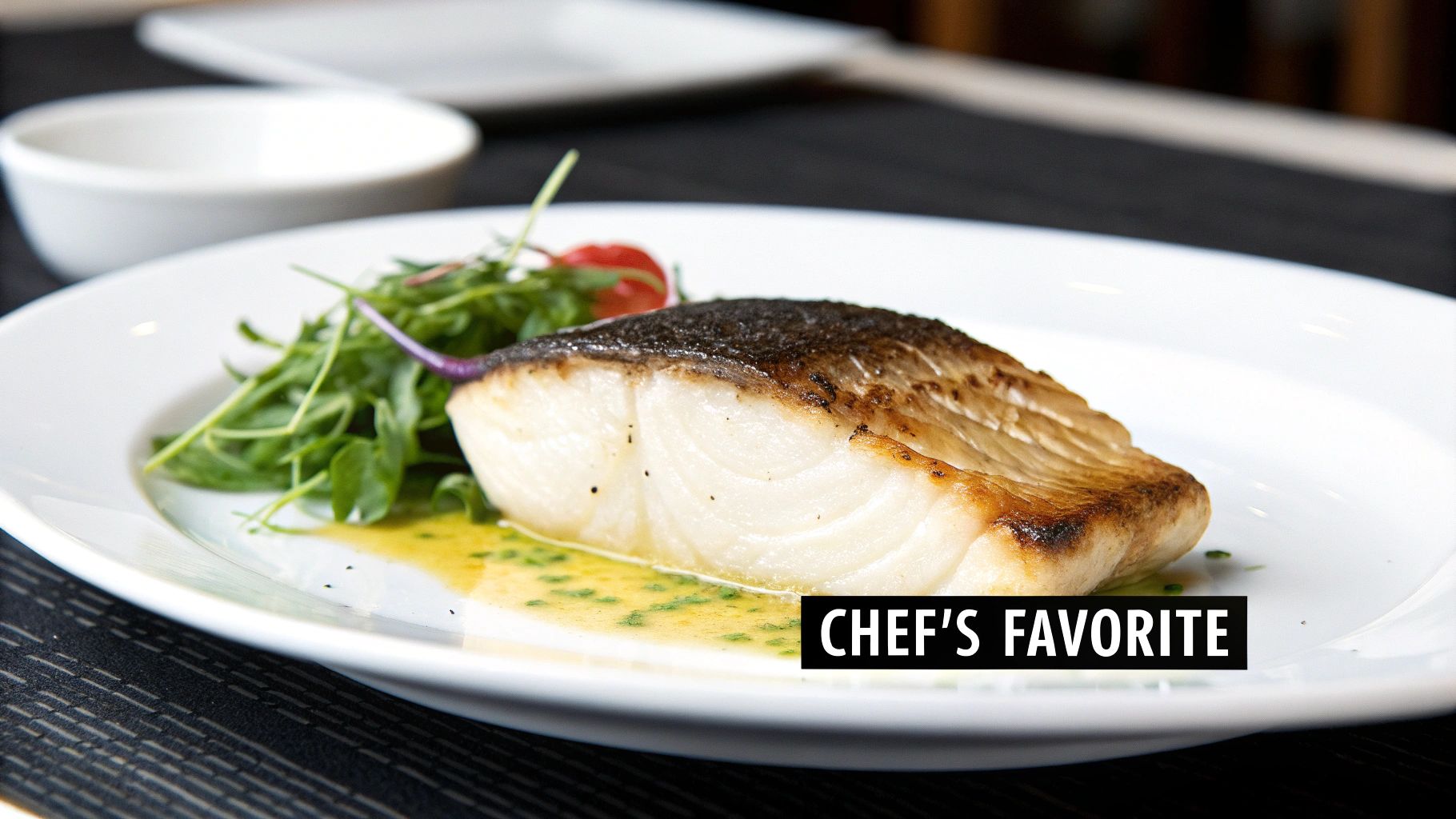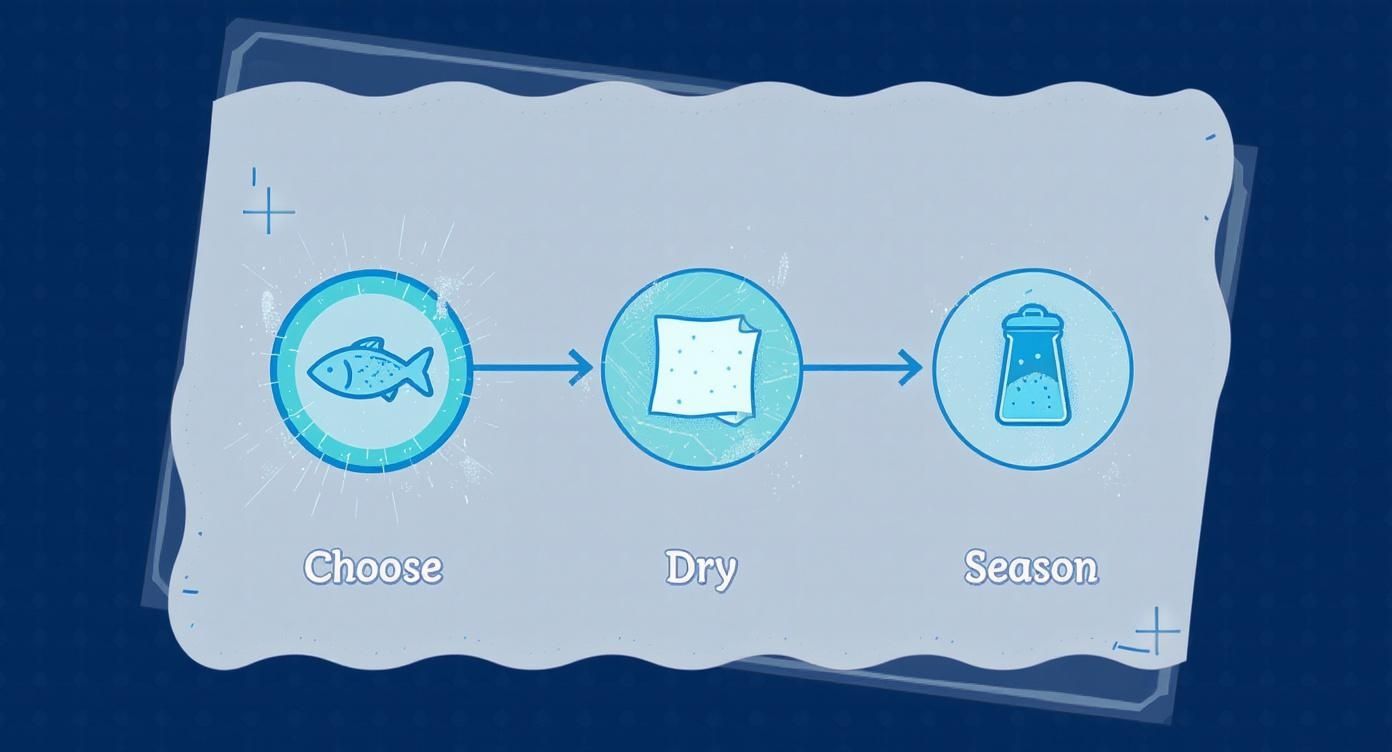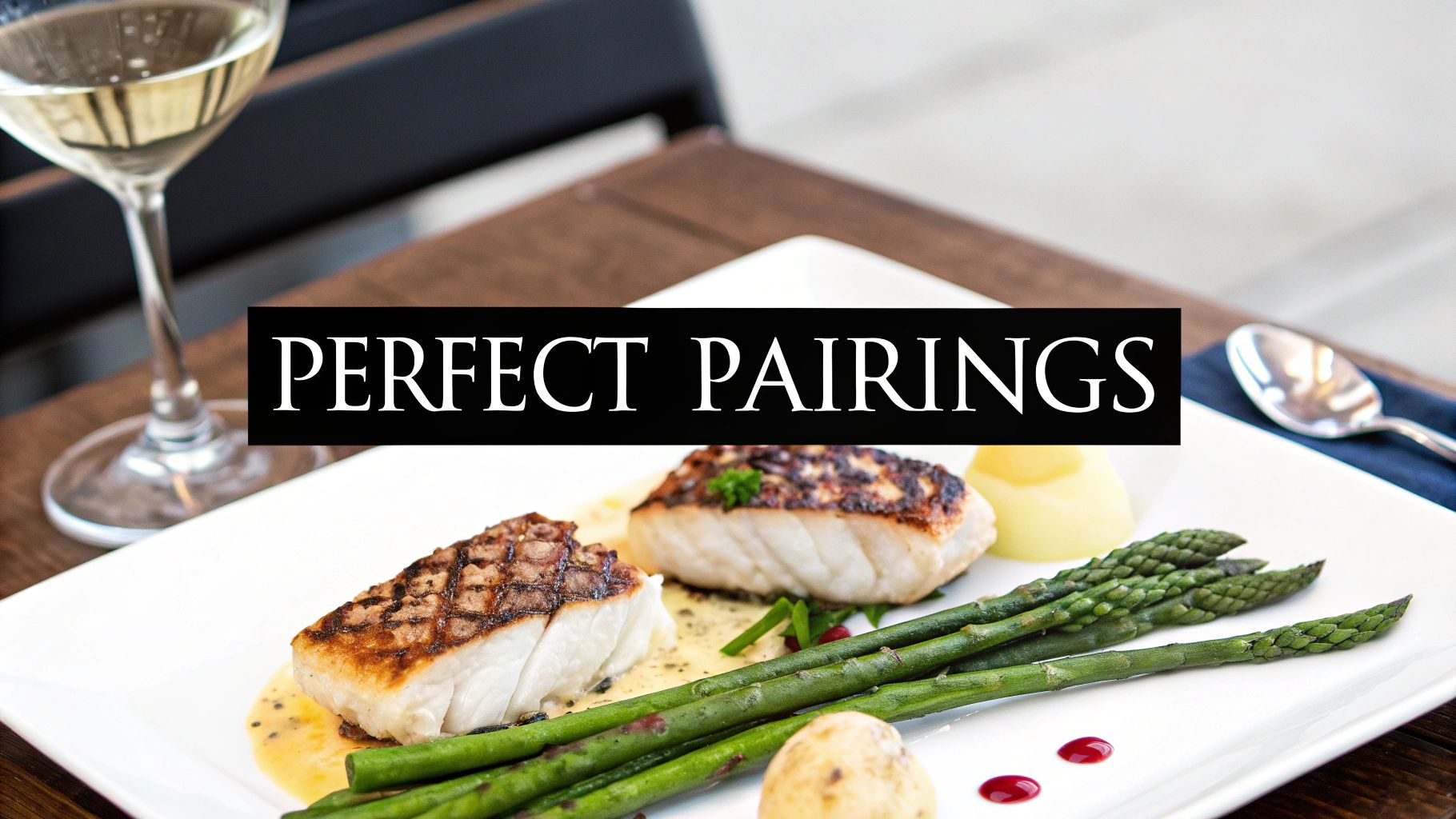Cooking Chilean sea bass is simpler than you might think. The best way? Pan-sear the fillet skin-side down in a hot, oiled skillet for 4-6 minutes until the skin turns golden and crispy. Flip it, cook for another 2-3 minutes, and you're done. This technique locks in that signature buttery flavor and creates a perfectly flaky texture every time.
Why Chefs Love Chilean Sea Bass

Ever wondered why Chilean sea bass is the star of so many high-end restaurant menus? It comes down to its rich, buttery flavor and an incredibly forgiving, high-fat content that makes it a dream to cook, even for novices. It’s a prized fish, but that doesn't mean it has to be intimidating.
This guide will show you exactly how to achieve that perfect, flaky texture. We'll start with the most reliable method—pan-searing—to get that crispy, golden skin and succulent interior. You'll learn the simple techniques that make this fish shine and gain the confidence to recreate a five-star dining experience right at home.
A Rise to Culinary Fame
Chilean sea bass, officially known as Patagonian toothfish, shot to fame in the 1980s when chefs discovered its unique qualities. By the early 2000s, U.S. demand was soaring, with Chile supplying over 80% of the American market.
Even with strict fishing quotas in place, it remains a fixture in premium restaurants where a single serving can easily top $50.
Key Takeaway: The high fat content is your secret weapon. It delivers a rich, melt-in-your-mouth texture and acts as a buffer against overcooking, making it one of the most forgiving fish you can prepare.
This natural richness means you don't need complicated marinades. A simple seasoning of salt and pepper is often all it takes to complement its delicate flavor.
For those interested in exploring premium seafood, you can check out our curated selection of high-quality seafood. Next, we’ll dive into the specifics of prepping and seasoning your fillet.
Selecting and Preparing Your Fillet
Your journey to a perfect meal starts at the fish counter. When you’re choosing Chilean sea bass, look for fillets that are a vibrant, pearly white and feel firm. The flesh should spring back when you press it lightly, and it should smell clean and oceanic—never fishy.
Given its history, sourcing sustainable sea bass is non-negotiable. Overfishing in the late 20th century led to strict regulations, but illegal fishing remains a problem, with some reports suggesting it accounts for 20-30% of the global supply. This has pushed conscientious chefs to seek out certified fillets. You can read more about these sustainability challenges in the sea bass market and why it's a conversation worth having.
Prepping for a Perfect Sear
Once you have your fish, the prep is simple but absolutely critical for getting that crispy skin everyone loves.
- Pat It Dry: Use a paper towel to pat the entire fillet completely dry, especially the skin. Moisture is the enemy of a good sear, full stop.
- Season Generously: Don't hold back. Use coarse sea salt and freshly cracked black pepper on all sides. This richly flavored fish doesn’t need much else.
- Let It Rest: Let the seasoned fillet sit at room temperature for about 10 minutes. This small step makes a huge difference in how evenly it cooks.
Bringing the fish to room temperature is a classic restaurant trick. It keeps the cold fillet from shocking the hot pan, which prevents sticking and ensures it cooks perfectly from edge to center.
This careful prep sets the stage for a flawless cook. If you're looking to source the highest quality fish, you can explore our selection of sustainably sourced Chilean Sea Bass.
Mastering the Pan-Searing Technique
If you want an irresistible contrast between crispy skin and a juicy, flaky interior, pan-searing is the way to go. This method is all about controlling heat and timing to get that perfect restaurant-quality result right in your own kitchen. It's faster than baking and gives you a texture you just can't get any other way.
First things first, you’ll need the right tools. A heavy-bottomed skillet—think cast-iron or stainless steel—is your best friend here. It distributes heat evenly and holds its temperature, preventing hot spots that can scorch the delicate skin before the fish cooks through.
Choosing the right cooking oil is also key. You need one with a high smoke point to prevent burning and get that perfect crust. Grapeseed, avocado, or canola oil are all excellent choices, but you can consult a cooking oil smoke point chart to see all your options.
This simple infographic breaks down the essential prep steps before your fillet even touches the pan.

Don't skip these steps. Choosing a good fillet, drying it properly, and seasoning it well are what ensure the skin gets perfectly crispy instead of just steaming in the pan.
Achieving the Perfect Sear
Get your skillet over medium-high heat and add a tablespoon of oil. When you see it shimmer, you know the pan is at the perfect temperature.
Gently place the seasoned fillet skin-side down in the hot pan. Press on it lightly with a spatula for about 10 seconds to make sure the entire skin makes contact with the surface.
Now for the hard part: leave it alone. Let it sizzle, undisturbed, for 4-6 minutes. You'll know it's ready when the skin naturally releases from the pan, golden brown and crisp.
Pro Tip: Don't try to force the flip. If the fillet is sticking, the skin hasn't finished crisping up. Give it another minute, and it should lift away easily.
Once the skin is perfect, flip the fish. The second side needs only 2-3 minutes to finish cooking through.
For an extra layer of flavor, toss in a knob of butter, a smashed garlic clove, and a sprig of thyme during the final minute. Tilt the pan and spoon that fragrant, bubbling butter over the fillet.
This technique is also fantastic for other rich, oily fish. If you're a fan of sea bass, you might also enjoy cooking with delicious Black Cod, which has a similarly luxurious texture.
Once done, remove your sea bass from the heat and let it rest for just a moment before serving.
While a good pan-sear gives you that iconic crispy skin, don't stop there. Chilean sea bass is incredibly versatile, and its high fat content makes it a dream for other cooking methods that play up its moist, flaky texture in completely different ways.
Two fantastic alternatives are baking and grilling, each bringing something unique to the table.
Baking for a Delicate, Aromatic Finish
Baking, especially using the en papillote (in parchment) method, is an elegant and almost foolproof approach. It’s a classic technique for a reason. You simply seal the fillet inside a parchment paper pouch with aromatics—think lemon slices, fresh herbs like thyme or dill, and maybe a splash of white wine.
As it bakes, the fish gently steams in its own juices, locking in moisture while soaking up all those surrounding flavors. What comes out of the pouch is an incredibly tender and succulent fillet. It's the perfect move for a lighter, more delicate preparation.
Grilling for a Smoky Char
Grilling, on the other hand, introduces a wonderful smoky char that beautifully contrasts the fish's rich, buttery flavor. But let's be honest, the delicate nature of sea bass requires a bit of care. Without the right prep, it can easily stick to the grates and fall apart.
Success on the grill really comes down to a few key things:
- Clean and Oil the Grates: This is non-negotiable. Use a grill brush to scrub the grates until they're pristine, then use a paper towel to apply a high-smoke-point oil.
- Get It Hot: Preheat your grill to a solid 375°F. A hot grate helps create an instant sear, which is your best defense against sticking.
- Use the Right Tools: A wide fish spatula is your best friend here. It’s essential for flipping the delicate fillets without breaking them.
Grilling is an excellent way to cook Chilean sea bass, especially for thicker cuts. The key is to create a non-stick surface and handle the fish gently, allowing it to develop a nice crust before you even think about moving it.
Once the grill is ready, cook the fillets for about 3-5 minutes per side, depending on how thick they are. You're aiming for a final internal temperature of 145°F for that perfect, flaky finish.
Chilean Sea Bass Cooking Method Comparison
Each cooking method—searing, baking, or grilling—draws out a different side of this amazing fish. Choosing the right one depends entirely on the texture and flavor you're after. This table breaks down what you can expect from each approach.
Whether you want the crispiness of a sear, the clean flavors of baking, or the smoky notes from the grill, you have plenty of delicious options for any occasion.
Perfect Pairings and Plating Ideas

You've cooked the perfect piece of Chilean sea bass. Now, how do you turn it into a truly unforgettable meal? It's all about choosing sides that lift the fish up instead of weighing it down.
The goal is harmony. You need textures and flavors that complement the rich, buttery profile of the sea bass. A creamy element, for instance, is a beautiful contrast to the crispy skin of a pan-seared fillet, while a touch of acidity is perfect for cutting through the fish’s natural richness.
Side Dishes That Just Work
The right side dish doesn't compete for the spotlight; it makes the main event shine even brighter. Here are a few pairings that I’ve found work exceptionally well:
- Creamy Lemon-Dill Risotto: This is a classic for a reason. The velvety risotto provides a lush base, while the bright lemon and fresh dill cut through the richness beautifully.
- Roasted Asparagus with Parmesan: Simple, elegant, and effective. The slightly bitter, earthy notes of asparagus get a salty kick from shaved Parmesan, offering a clean contrast.
- Silky Parsnip Purée: If you want something a little different from mashed potatoes, this is it. A parsnip purée is subtly sweet and incredibly smooth, creating the perfect canvas for the fillet.
Wine Pairings and Presentation
A great wine pairing is non-negotiable—it elevates the entire experience. With a fish this decadent, you’ll want a wine with enough crispness to cleanse the palate between bites. A sharp Sancerre is an excellent choice. If you prefer Chardonnay, go for one that’s lightly oaked to echo the fish's buttery notes without overwhelming them.
When it comes to plating, think elegance and structure. A standard 6-ounce fillet delivers about 25 grams of protein and is surprisingly light on calories, making it a healthy but substantial centerpiece. You can dig deeper into its impressive nutritional profile to see just how it fits into a modern, healthy diet.
Plating Tip: Go for height. Start with a spoonful of risotto or purée as your base. Gently place the sea bass fillet on top, then lean your roasted vegetables against it. A final garnish—a few fresh dill fronds or some microgreens—adds that pop of color and a professional finish.
A Few Common Questions About Cooking Sea Bass
Even when you follow a recipe to the letter, a premium fish like Chilean sea bass can bring up a few questions in the kitchen. Getting the small details right is what separates a pretty good meal from an unforgettable one. Here are some of the most common things chefs and home cooks ask when they’re working with this fish.
The biggest one? Knowing exactly when it's done. The easiest visual cue is when the flesh turns from translucent to a solid, opaque white and flakes easily when you nudge it with a fork. But for absolute certainty, nothing beats an instant-read thermometer.
You're aiming for an internal temperature of 145°F (63°C). I always pull it off the heat just a hair before it hits that number. The residual heat will carry it the rest of the way, keeping it perfectly moist instead of pushing it over the edge into dryness.
To Skin or Not to Skin
People often wonder whether they should cook Chilean sea bass with the skin on. My answer is almost always yes. The skin acts as a protective layer, holding in moisture and keeping the delicate flesh from falling apart. Plus, when you get a good, hard sear on it, the skin turns incredibly crispy—a fantastic textural contrast to the buttery fish.
If you really prefer it skinless, that’s fine. Just be a bit more gentle when handling the fillet and shave a minute or two off the cooking time.
So, why the high price tag? It really comes down to a few key factors:
- Remote Habitat: This fish lives in the deep, cold waters of the Antarctic, which makes the fishing process itself incredibly challenging and expensive.
- Strict Quotas: To keep the fishery sustainable and prevent overfishing, there are tight international regulations that limit how much can be caught each year.
- High Demand: It’s a star on fine dining menus around the world, and that popularity keeps market prices firm.
And finally, if you find yourself with leftovers, step away from the microwave. The best way to reheat it is gently. Pop the fillet in a covered dish and warm it in a 275°F (135°C) oven for about 10-15 minutes. A little splash of broth or water in the dish helps keep it from drying out.
Discover the difference that truly premium, sustainably sourced seafood makes. At WorldClass, we've curated a collection of provisions to help elevate your craft. Shop the collection at WorldClass.com.







.webp)






